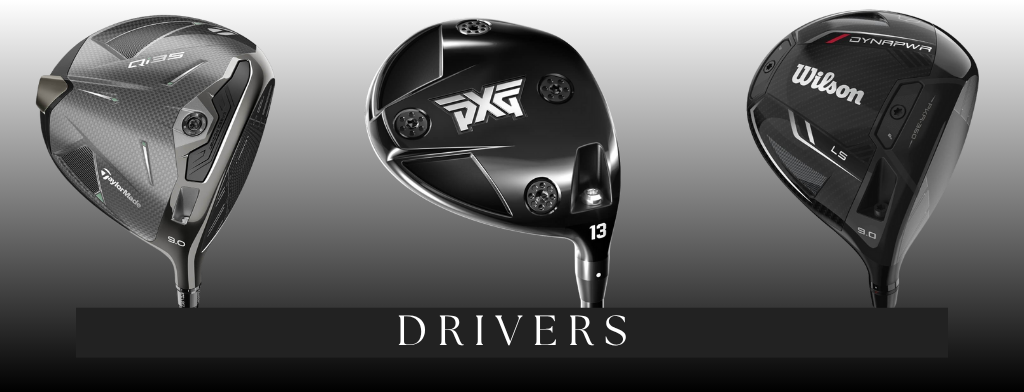How do you choose the right driver?
- Posted on
- By Wilco Jordaan , Gijs van Aken
- 0

"I'm ready for a new driver, but I have no idea what to buy." Perhaps this dilemma sounds familiar to you? There’s such a wide range of options, and according to most retailers, they’re all fantastic... In this blog, we’ll give you some guidance to help you make the right driver choice. Earlier, we wrote a blog about what goes on in golfers’ minds when they’re ready for a new driver. Enjoy reading!
You Have No Idea… A Familiar Problem?
Perhaps this sounds familiar: you’re ready for a new driver, but you have no idea which one to buy. Why choose brand A instead of brand B? Of course, our opinion isn’t the ultimate truth either, but a few helpful pointers are always welcome. Besides the obvious choices such as left-handed or right-handed, there are a few important things to keep in mind. Below, we’ll explain what to look out for. It’s nice that you don’t have to figure everything out yourself — we’re happy to help you on your way.
When Is It Time for a New Driver?

The golf equipment market continues to evolve steadily. When it comes to drivers, nearly all major brands release updated models every year, with new designs, new features, and new technologies. These innovations are usually intended to make the driver easier to handle (more forgiving) and/or more effective (better performing).
In the past 10 years, a lot has changed and improved. So, when should you start thinking about replacing your driver? There’s really only one right answer: when you feel it’s time.
Of course, if you’ve literally broken it in half, you’ll have no choice but to replace it. But aside from that, golf is a sport of feel, much of it happens in the mind. To play well with a club, you have to feel confident with it. If you’ve lost trust in your driver, replace it, chances are you’ll be much happier.
Some golfers buy the latest model every year, while others keep playing with the same driver until it falls apart after 10 years. On average, amateur golfers use the same driver for about four years before wanting a replacement. Over that time, technological improvements are significant, so you’ll definitely see benefits from upgrading. And since a new driver is a big investment, you want to make sure it’s worth it.
So when should you replace your driver?
- When it breaks,
- When you’ve lost confidence in it, or
- When you want to experience the latest technology and benefit from modern advancements.
Which Brand Should You Choose?
First of all, you don’t have to choose anything specific. There are quite a few brands to pick from when it comes to drivers. Most brands, however, design their clubs based on similar principles, so the differences between them are often smaller than you might expect.
If you go for a premium A-brand driver, you can be confident that you’re up to date in terms of technology and that you’ll be using a high-quality product with minimal risk of manufacturing defects, and that’s always reassuring.
As you can see in our online shop, we fully stand behind the A-brands PXG, Mizuno, TaylorMade, and Wilson. Which brand you prefer is, of course, a personal matter, design, specifications, and features will determine which driver truly suits you.
How Do Women’s Drivers Differ from Men’s Drivers?
Within every brand, there’s a distinction between drivers for men and for women. Often, the only difference is the shaft, but sometimes the shape, color, or head characteristics vary too.
In most cases, the clubhead itself is suitable for both men and women, but female golfers with average swing speeds usually need a ladies-flex shaft. These shafts are more flexible than men’s shafts because women are generally less explosive in their swing motion.
However, many experienced female golfers with higher swing speeds should actually use a men’s shaft, because a ladies-flex would be too soft. A shaft that’s too flexible causes a loss of distance and makes it harder to control direction.
View all Mizuno Drivers View all Taylormade Drivers View all Wilson Drivers
What Features Should You Look For?
It’s actually quite simple: the driver is meant to hit your ball as far and as accurately as possible from the tee. But your skill level determines which driver characteristics you need to play well.
For beginners, a “Game Improving” (forgiving) driver is ideal. This means that even when you don’t strike the ball perfectly (which happens a lot early on), you’ll still maintain reasonable distance and direction, a bit of technical assistance, so to speak.
A large sweet spot and a low center of gravity are also very helpful.
- The sweet spot is the ideal contact point on the clubface that launches the ball optimally. The larger it is, the better for beginners.
- A low center of gravity helps you get under the ball more easily, producing a higher and more consistent launch.
Advanced golfers, on the other hand, tend to focus on maximum distance and shot shaping rather than forgiveness. They strike the ball more cleanly and value feedback the vibration and sound at impact tell them how well they struck the ball. That information helps fine-tune the next shot.
Huh... Movable Weights?
Many high-end drivers now feature adjustable weights on the clubhead that allow you to fine-tune the balance and ball flight. This is useful if you want to shape shots, for example, hitting a draw (a slight curve from right to left).
You’ll see many PGA Tour professionals use these adjustments to control their trajectory more precisely and minimize deviation. If your swing naturally produces a consistent miss (like a fade or slice), these adjustments can also help compensate for that. In general: the farther the weights are from the clubface, the more forgiving the driver becomes.
What About Loft and Adjustability?
“Loft” refers to the launch angle of the clubface. In simple terms:
- Beginners usually need a higher loft.
- As your skills improve, you can handle a lower loft.
A higher loft (11.5–15°) gives a higher, more controllable ball flight and makes it easier to make clean contact. For advanced players, though, a high trajectory can mean loss of distance , especially on long holes, so they often prefer a lower loft (8–11°) for a flatter, longer drive.
That said, a too-low loft isn’t ideal if your swing speed is moderate, you still need enough height for the ball to stay airborne and maximize distance.
Most modern drivers come with adjustable lofts, which is a great feature. As you gain experience, you can fine-tune your loft using the included adjustment wrench. This flexibility helps you grow with your driver and experiment with what works best for you. A session at the driving range will quickly show you what feels right.
What About Shaft Flex?
Modern drivers all come with graphite shafts, which are lightweight and help increase swing speed, but only if the shaft’s flexibility suits your swing.
Common flex options are:
- Ladies Flex
- Light Flex (Senior Flex)
- Regular Flex
- Stiff Flex
- Extra Stiff Flex
The rule of thumb:
The faster your swing speed, the stiffer your shaft should be. If your shaft is too flexible, you’ll lose control. If it’s too stiff, you’ll lose distance because the shaft won’t release its stored energy at the right moment.
A common mistake among slightly advanced golfers is switching too quickly to a stiff flex, even though their swing speed and technique aren’t ready for it yet. That’s a shame, because Regular Flex suits about 80% of golfers.
- Light and Ladies Flex → for slower swing speeds (seniors, most women)
- Stiff and Extra Stiff → for faster swing speeds (advanced players)
Some women with faster swings (for example, former hockey players) do just fine with a men’s Regular Flex shaft.
Golf, as you’ve probably realized, is largely a mental game. So these guidelines aren’t set in stone. I know an advanced golfer who hits straight 250-meter drives with a Senior Flex driver, you’d be amazed how much that shaft bends during his swing! And yet, it works beautifully. So don’t hesitate to try your friend’s driver to see what feels (and doesn’t feel) good for you. It can help a lot.



Comments
Be the first to comment...